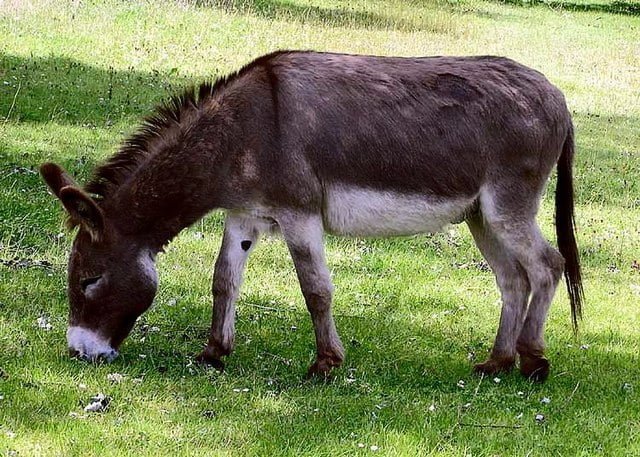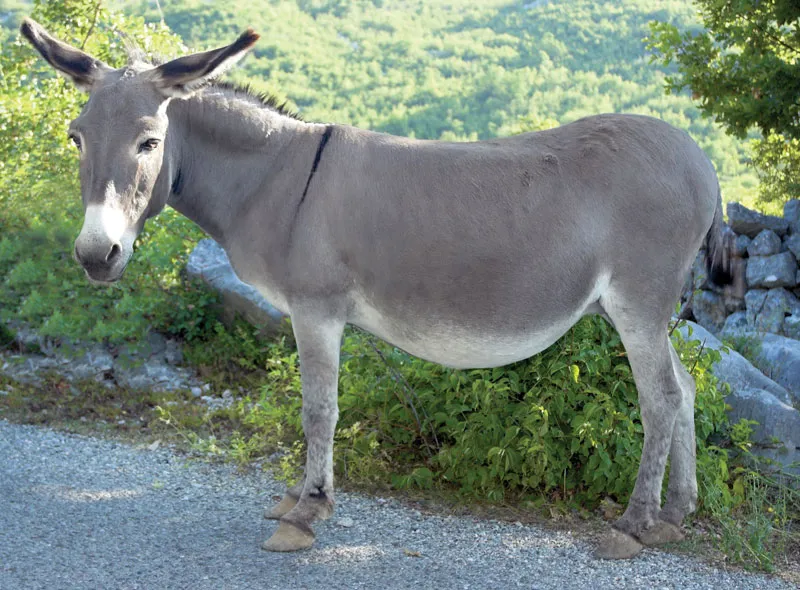Donkey Facts, FAQs, Behaviour, Habitat and Conservation
 Donkey Facts
Donkey FactsDonkey Facts | Description | Distribution and Habitat | Conservation | Behaviour and Ecology | Interaction with Human | Cultural | Interesting facts | frequently asked questions about Donkey
The donkey, a domesticated mammal that has been a loyal companion to humans for thousands of years, is a fascinating and highly adaptable creature. With its distinctive long ears, braying call, and surefootedness, the donkey has served as a beast of burden, transportation, and even as a loyal friend and guardian. Despite its humble appearance, this remarkable animal has played an essential role in shaping human civilization, and continues to do so today. In this article, we will explore the history, behavior, and unique characteristics of the donkey, shedding light on why this amazing mammal is truly one of a kind. So saddle up and join us on a journey into the world of the donkey!
Taxonomy of Donkey
| Kingdom | Animalia |
|---|---|
| Phylum | Chordata |
| Class | Mammalia |
| Order | Perissodactyla |
| Family | Equidae |
| Genus | Equus |
| Species | E. africanus or E. asinus |
| Subspecies* | E. a. africanus, E. a. somalicus, E. a. asinus, E. a. atlanticus, E. a. mohr |
Morphology of Donkey
| Feature | Description |
|---|---|
| Size | Height: 90-160 cm (at the shoulder); Length: 1.2-1.5 m |
| Weight | 90-480 kg (depending on breed and gender) |
| Body Shape | Stocky and muscular, with a large head and long ears |
| Coat | Short, smooth hair that can be a variety of colors |
| Hooves | Hard and durable, with a thick sole and concave shape |
| Teeth | Hypsodont (continuously growing) teeth with a dental formula of 2(3/3)-1(0/1)-3(3/4)-3(3/4) |
| Eyes | Large and expressive, with good vision and depth perception |
| Ears | Long and pointy, capable of swiveling to detect sounds from any direction |
| Tail | Long and thin, with a tassel at the end |
| Vocalizations | Braying call that can be heard for miles |

Description of Donkey
The donkey (Equus africanus asinus) is a domesticated mammal that belongs to the Equidae family. It is a member of the same family as horses and zebras. Donkeys have a stocky and muscular body with a large head, long ears, and a long, thin tail. Their coat is short and smooth and can be a variety of colors, including gray, brown, black, and white. Donkeys have hard and durable hooves with a thick sole and concave shape, which make them well-suited for walking on rough terrain.
Donkeys are known for their distinctive vocalizations, which include a loud, braying call that can be heard for miles. They have large, expressive eyes and excellent vision and depth perception, which help them navigate their environment. Their long, pointy ears are capable of swiveling to detect sounds from any direction, making them excellent at detecting potential threats or predators.
Donkeys are herbivores and graze on a variety of plants, including grasses, shrubs, and trees. They have a unique digestive system that allows them to extract as much nutrition as possible from their food, which is necessary for survival in harsh, arid environments. Donkeys are also well-known for their stubbornness and can be difficult to train or handle. However, with proper training and handling, they can be loyal and affectionate companions.
Overall, the donkey is a fascinating and adaptable mammal that has played an important role in human history and continues to do so today.
Distribution and habitat of Donkey
Donkeys (Equus africanus asinus) are a widely distributed mammal found throughout the world. They are native to arid regions of Africa, specifically the northern and eastern regions of the continent. However, due to human intervention, they have been introduced to other parts of the world, including the Americas, Australia, and Asia.
In their natural habitat, donkeys inhabit arid and semi-arid regions, such as deserts, savannas, and scrublands. They have adapted to these harsh environments and are able to survive in areas where water and food are scarce. Donkeys are known for their ability to go long periods of time without water, and they have a unique digestive system that allows them to extract as much nutrition as possible from their food.
In some parts of the world, donkeys are still used for transportation and work, such as carrying heavy loads or plowing fields. They are also kept as companion animals and are sometimes used for their milk and meat. However, in many regions, donkeys are facing threats such as habitat loss, hunting, and exploitation.
Overall, the distribution and habitat of donkeys reflect their adaptability and resilience in harsh environments. However, the continued human intervention and exploitation of these animals highlights the need for conservation efforts to protect these unique and valuable creatures.
Behaviour and Ecology of Donkey
Donkeys (Equus africanus asinus) are highly social and intelligent animals that exhibit a variety of complex behaviors. They are able to form strong bonds with other donkeys as well as with humans, and are known for their loyalty and affection towards their companions.
In their natural habitat, donkeys typically live in herds with a dominant male or “jack” that protects the group from predators. Donkeys are well-adapted to their arid environment and have developed a number of unique behaviors to cope with their surroundings. For example, they are able to detect water sources from a distance and will navigate towards them even if they are hidden or difficult to reach.
Donkeys are herbivores and primarily graze on tough, fibrous vegetation. They have a unique digestive system that allows them to extract as much nutrition as possible from their food, which is necessary for survival in their arid environment. They are also able to go long periods without water, and have been known to survive for days or even weeks without access to fresh water.
In terms of reproduction, donkeys typically breed during the rainy season when food and water are more abundant. Females carry their young for around 12 months, and the foal is able to stand and nurse within hours of birth. Donkeys have a relatively long lifespan for a domesticated animal, with some individuals living into their 40s.
Overall, the behavior and ecology of donkeys reflects their adaptability and resilience in harsh environments. However, their continued exploitation and habitat loss highlights the need for conservation efforts to protect these unique and valuable creatures.
Conservation of Donkey
Donkeys (Equus africanus asinus) are an important domesticated animal and have played a crucial role in human history. However, in some parts of the world, donkeys are facing threats such as habitat loss, hunting, and exploitation. Therefore, conservation efforts are necessary to protect and preserve these valuable creatures.
One of the key steps in conserving donkeys is to protect their natural habitats. This includes preserving the arid regions where they live and ensuring that there is enough food and water available for them to survive. Habitat loss due to human activities such as mining and construction can be particularly damaging to donkey populations, and efforts should be made to minimize the impact of such activities.
Another important aspect of donkey conservation is to address the issue of overexploitation. Donkeys have been used for transportation and work for thousands of years, and their meat and milk are also consumed in some parts of the world. However, overuse of these animals can lead to depletion of populations and genetic diversity. Therefore, conservation efforts should focus on promoting sustainable use of donkeys and preventing overuse.
Finally, education and awareness are important tools in donkey conservation. Many people are unaware of the importance of these animals and the threats they face, and therefore, raising awareness about the importance of donkeys and the need for their conservation can help to mobilize support for conservation efforts.
In conclusion, donkey conservation is a critical issue that requires a multifaceted approach. Protecting their habitats, addressing overexploitation, and raising awareness are all important steps in ensuring the survival and well-being of these valuable animals.
Interaction with Human of Donkey
Donkeys (Equus africanus asinus) have a long history of interaction with humans and have been domesticated for thousands of years. They have been used for transportation, work, and as companion animals in many parts of the world.
Donkeys are known for their gentle nature and are often kept as pets or working animals by farmers and ranchers. They are well-suited to a variety of tasks, such as carrying heavy loads, plowing fields, and providing transportation in rural areas. They are also used for their milk and meat in some parts of the world.
In addition to their practical uses, donkeys also have cultural significance in many regions. For example, in some cultures, donkeys are seen as symbols of humility and hard work. They are also associated with Christmas in some parts of the world, and are used in nativity scenes to represent the animal that carried Mary and Joseph to Bethlehem.
However, despite their importance to human cultures and livelihoods, donkeys are often mistreated and exploited. In some regions, they are overworked, underfed, and subjected to cruel treatment. This is particularly true in areas where traditional methods of transportation and work are still in use, and where there is limited awareness of animal welfare issues.
Overall, the interaction between donkeys and humans reflects the long and complex history of domestication and exploitation of these animals. While they are valued for their practical uses and cultural significance, there is a need for greater awareness of animal welfare issues and the importance of responsible use and conservation of these valuable creatures.
Cultural and Historical Significance of Donkey
Donkeys (Equus africanus asinus) have had a significant cultural and historical impact throughout the world. They have been domesticated for thousands of years and have played important roles in the lives of many different cultures and societies.
In many parts of the world, donkeys are seen as symbols of hard work and humility. They have been used for transportation and work for centuries, and are valued for their ability to carry heavy loads and navigate difficult terrain. In some cultures, donkeys are also associated with spirituality and religious beliefs. For example, in Christianity, donkeys are often depicted in nativity scenes as the animal that carried Mary and Joseph to Bethlehem.
Donkeys have also been celebrated in literature and the arts. They have been featured in many classic works of literature, such as “Don Quixote” and “The Tale of Benjamin Bunny.” They have also been depicted in artwork throughout history, including in ancient Egyptian hieroglyphics and in the paintings of famous artists such as Vincent van Gogh.
However, despite their cultural and historical significance, donkeys have also been subjected to exploitation and mistreatment throughout history. They have been used for labor and transportation, and their meat and milk have been consumed in some parts of the world. In some regions, they are still subjected to harsh treatment and overwork, highlighting the need for greater awareness of animal welfare issues.
Overall, the cultural and historical significance of donkeys reflects the deep and complex relationship between humans and animals throughout history. While they have been celebrated for their practical uses and cultural significance, there is also a need for responsible use and conservation of these valuable creatures.
Explanatory Notes for Donkey
Explanatory notes for donkeys (Equus africanus asinus) provide additional information and context about these animals. Some important explanatory notes about donkeys include:
- Taxonomy: Donkeys belong to the same family as horses and zebras, and are a subspecies of the African wild ass. Their scientific name is Equus africanus asinus.
- Morphology: Donkeys have a distinctive appearance, with long ears and a short, stocky build. They range in size from small, miniature donkeys to large, working donkeys. They come in a variety of colors, including brown, gray, and black.
- Distribution and habitat: Donkeys are found throughout the world, but are most common in arid and semi-arid regions. They are well-suited to these environments, as they are able to conserve water and navigate difficult terrain.
- Behavior and ecology: Donkeys are social animals and are often kept in herds. They are well-adapted to a variety of tasks, such as carrying heavy loads and navigating difficult terrain. They are also known for their gentle nature and can make good companion animals.
- Cultural and historical significance: Donkeys have played important roles in human history, serving as transportation and work animals for thousands of years. They have also been celebrated in literature and the arts, and have cultural significance in many regions of the world.
- Conservation: Donkeys face threats such as habitat loss, overexploitation, and mistreatment. Conservation efforts are necessary to protect and preserve these valuable animals, including protecting their habitats, promoting sustainable use, and raising awareness about animal welfare issues.
Overall, explanatory notes provide important additional information about donkeys, helping to deepen our understanding of these fascinating and important animals.
Interesting facts about Donkey
Here are 10 interesting facts about donkeys (Equus africanus asinus):
- Donkeys are highly intelligent animals and have been shown to have excellent problem-solving skills.
- Contrary to popular belief, donkeys are not stubborn animals. They are actually very cautious and will not do something that they feel is dangerous or uncomfortable.
- Donkeys have a unique vocalization called a bray, which can be heard from several miles away.
- Donkeys are capable of carrying up to 30% of their own body weight, making them valuable working animals.
- Donkeys have a natural aversion to canines and will often act as protectors for other farm animals such as sheep and goats.
- Donkeys have a reputation for being very tough and resilient animals, able to survive in harsh and unforgiving environments.
- Donkeys have a keen sense of hearing and are able to detect sounds from much further away than humans.
- Donkeys are social animals and thrive when they are kept in groups.
- Donkeys are often used in therapy programs for children and adults with disabilities due to their calm and gentle nature.
- Donkeys are capable of living for up to 50 years, making them one of the longest-lived domestic animals.
General queries or frequently asked questions about Donkey
What is the difference between a donkey and a mule?
A donkey is a species of animal, while a mule is a hybrid animal created by crossing a male donkey (jack) with a female horse (mare). Mules are sterile and cannot reproduce.
What do donkeys eat?
Donkeys are herbivores and primarily eat grass, hay, and other plant material. They also require fresh water and can drink up to 10 gallons of water per day.
How long do donkeys live?
Donkeys have a lifespan of around 25-30 years, although some can live up to 50 years with proper care.
Are donkeys good pets?
Donkeys can make excellent pets and companions, as they are gentle and social animals. However, they require a significant amount of care and attention, including proper nutrition, shelter, and veterinary care.
Do donkeys like to be ridden?
Some donkeys can be trained to be ridden, but it is important to ensure that the donkey is properly trained and comfortable with the rider’s weight. It is also important to use appropriate equipment and to ride the donkey for short periods of time to avoid causing discomfort or injury.
Can donkeys swim?
Donkeys are capable of swimming, but not all donkeys enjoy it. It is important to ensure that the water is safe and appropriate for the donkey and to supervise them while they are swimming.
How do donkeys communicate?
Donkeys communicate with each other through a variety of vocalizations, including braying, snorting, and grunting. They also use body language, such as ear position and tail movement, to communicate their mood and intentions.
What is a jenny donkey?
A jenny donkey is a female donkey, while a male donkey is called a jack.
Conclusion
In conclusion, donkeys are fascinating and intelligent animals that have played an important role in human history. They are well-adapted to harsh environments and have unique characteristics, such as their ability to carry heavy loads and act as protectors for other farm animals. Donkeys require proper care and attention, including proper nutrition, shelter, and veterinary care. Despite their many benefits, donkeys have faced challenges in terms of conservation due to habitat loss, overuse, and other factors. It is important to recognize the cultural and historical significance of donkeys and to work towards their protection and conservation for future generations to appreciate and benefit from.












